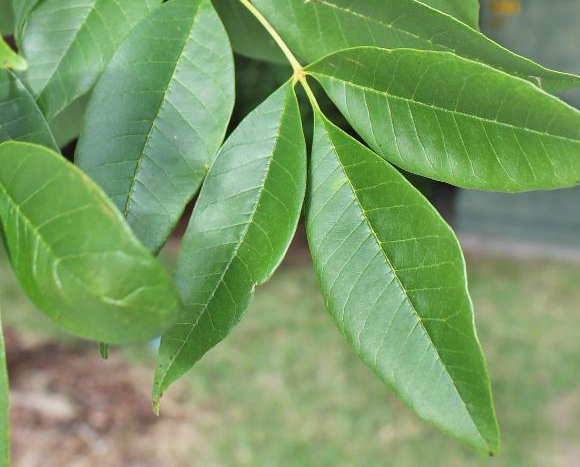
by Daniel J. Leonard | Jun 2, 2022
The Oracle of Omaha, Warren Buffett, once said “Someone is sitting in the shade today because someone planted a tree long ago.” While that’s all fine and good and I’m happy that the next generation gets to enjoy the things we grew, most of us would like to enjoy shade in our lifetimes too! If you too want to plant your own shade, one of the best rapidly growing shade tree choices for the Panhandle is the majestic Florida native Green Ash (Fraxinus pennsylvanica).
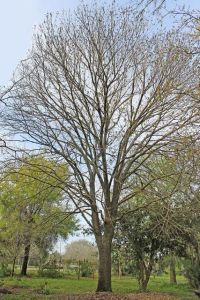
Green ash trees have a vase shape form. Photo Credit: University of Florida/IFAS
Green Ash is a large (50-100’ tall), oval-shaped, deciduous shade tree native to the entire eastern half of North America, but best of all for those of us craving shade, it grows to its mature height in a relative hurry. While most trees that grow extremely fast tend to be inherently weak and short-lived, this is not the case with Green Ash. Capable of growing 6-10’ in a single year if irrigated and fertilized appropriately and often living well over 100 years, there aren’t many plants in the Panhandle that grow quicker or live longer.
There’s much more to Green Ash than growth rate and life span, however. The tree is also one of the prettiest around. Come on, you didn’t think I’d recommend an ugly plant, did you? A look up into the canopy at different times of the year and one can see the tree’s deep, dark green foliage, good-for-Florida yellowish fall color, and slightly showy light green seed pods. Below, the straight trunk is laced with distinctive diamond-shaped bark that hints at the extremely high-quality wood underneath. Fun fact, Ash is historically the most popular wood used to make baseball bats due to its hardness at a relatively light weight – more MLB home runs have been hit with Ash than any other species!
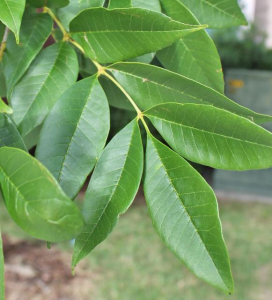
The compound leaf of a green ash tree. Photo Credit: University of Florida/IFAS
As a Florida-Friendly plant, Green Ash is fairly low-maintenance and provides many environmental services. The species, like any other plant, requires supplemental water and fertilizer during the establishment period, generally the first year or so after planting, but doesn’t demand much else from gardeners after that. Green Ash specimens in Florida also don’t have much in the way of pest problems (the invasive Emerald Ash Borer has devastated ash populations in northern states but thankfully has not yet been found in Florida). However, as a host plant for several native pollinators, including the Eastern Tiger Swallowtail, Mourning Cloak, Orange Sulphur, and Viceroy Butterflies, you may occasionally find caterpillars munching away on the tree’s foliage. If you can handle a little leaf damage, try to leave any caterpillars alone and enjoy the stunning butterflies they later morph into!
Green Ash is a beautiful, ultra-adaptable shade tree. Though the species prefers moist areas, there aren’t many sites the tree can’t thrive in. Do you have a low-lying area near a swamp or stream that stands in water from time to time? Great! Green Ash will thrive. Do you need a street tree to survive in a harsh environment with a cramped root zone surrounded by concrete? Green Ash will be right at home there as well. Green Ash is simply a classic shade tree with many interesting attributes that improves the look of any landscape it occupies. Plant one today!
For more information about Green Ash, other shade tree species, or any other horticultural/agricultural topic, contact us at the UF/IFAS Calhoun County Extension office.
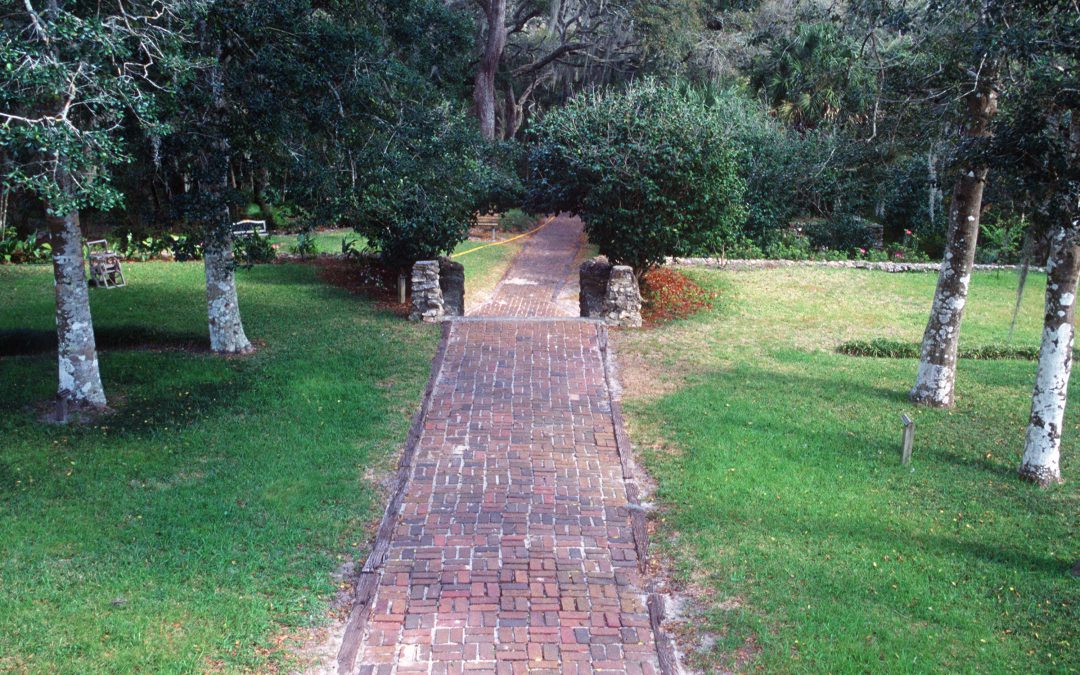
by Joshua Criss | Jun 2, 2022
The lawn is a staple when you picture the typical American home. It is where your kids play, where you stand to associate with your neighbors and the first impression you give to passers-by. It has also no doubt been a subject of frustration as you notice brown patches or open spots. Could this situation have been avoided in the first place? Lawn care is a topic we address in extension extensively. Proper maintenance practices will help your lawn be green and healthy providing you with years of enjoyment. Below are a few principles that if applied will help you avoid issues and grow a worry-free yard.
First Steps
Before you do anything else you will need to know what species you are working with. In this area we have warm season grasses with names like centipede and zoysia. Their individual characteristics will identify yours from the others. For instance, centipede grass is a lighter color with a course textured blade about 1/16 to 1/8 inches wide and a creeping habit as it spreads via stolon. This is very basic, as identifying grasses could be a day long course on its own. Knowing your lawn species will inform you as to mowing height and when periodic tasks such as dethatching may be necessary. All of these are necessities for a healthy lawn, but there are two universal tasks that need to be on the forefront of your mind.
Irrigation
Irrigation is arguably the most important topic in lawn care. Improper watering may cause your grass to die back opening bare spots for weeds and insects to infiltrate. Scheduled irrigation is not the best option. Your grass will tell you when it needs water. Look for indicators such as folding blades, color change, and lingering footprints as keys to irrigation. When you see these, apply ½ to ¾ inch of water preferably in the early morning. Take your soil type into consideration when watering as you will want this water in the root zone. Sandy soils may need a little more to saturate the area while clay may need to soak in through multiple applications. Watering only when required will encourage deeper rooting of your grass. So, how do you know how long to run your system? Calibrate your system by placing straight sided cans in your watering zones. Run the system until they fill to the desired level. The amount of time this takes will tell you how long you should run the system. While you are calibrating the system, take a look at where the sprinkler heads are aimed. Readjust any that place water in undesired locations like the street. Lastly, install a rain sensor. The Panhandle received an average 68.32 inches of rain in 2021*. There is no need to run your water system if mother nature is doing it for you.
*per FL Climate Survey https://climatecenter.fsu.edu/images/docs/Fla_Annual_climate_summary_2021.pdf
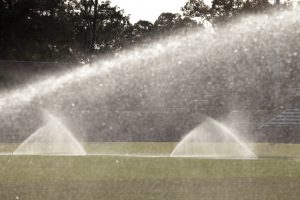
UF/IFAS Photo by Tyler Jones.
Fertilizing
Fertilization is another often misunderstood topic. Grass is a plant, and therefore requires nutrients to thrive. Over doing it in certain grasses may cause them to die back much like improper irrigation. Application rates vary by grass species and are given in terms of required nitrogen per 1000ft2 for a single growing season. You can tell how much Nitrogen a fertilizer has by looking at the first of the three-digit NPK rating. It indicates the amount by weight in the bag (8-8-8 = 0.08lbs nitrogen per 1lb fertilizer). Keep in mind that rate of fertilizer your grass needs is for the entire year. This means you will want to apply multiple times. So, if you need 13lbs of fertilizer it is best to apply about 4.33lbs three times across the growing season versus all at once. Only apply fertilizer during active growth. In the Panhandle this is mid-April through mid-September. Appropriate rates and timing will keep those expensive fertilizers in your root zone and not in our local waterways.
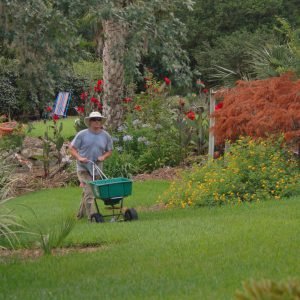
UF/IFAS Photo
Appropriate care will provide lush healthy growth and a full lawn. Taking the time to identify your grasses will inform you as to what it needs to support your family for years to come. Appropriate irrigation and fertilization will in-turn support the health of local watersheds and potentially save you some money and effort. For more information on lawn maintenance, see these Ask IFAS documents, or contact your local extension agent for additional information on this and any topic regarding your gardens and more.
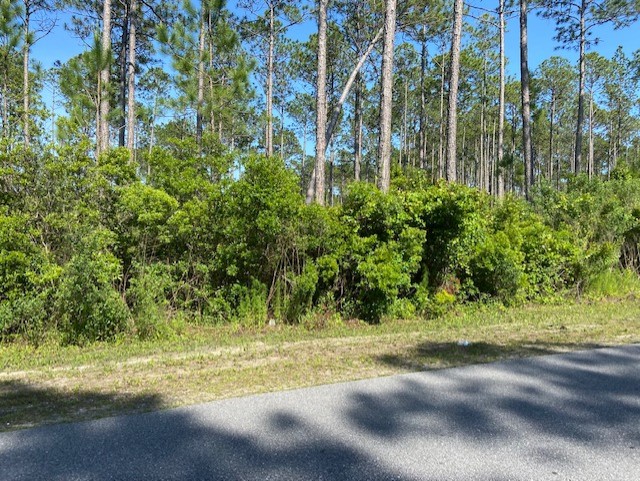
by Stephen Greer | May 26, 2022
Are you Firewise with your home landscape? We plan for many situations in our lives from homeowner insurance to maintaining the car to planning for the future. Planning for defensive space around your home should also be part of long-term planning to protect it from possible wildfires.
Landscaping adds value to your home and with proper planning, planting and management it can be the first line of defense against a potential woodland fire. The first step is to plan a defensible space between your home and woodlands. This will be your buffer to slow, redirect or stop the fire movement. This buffer area can be planned and planted into a beautiful setting for all to enjoy with correct plant choices and maintenance.
The minimum of 100 feet is recommended space from the house and other structures to woodland areas that may have dense understory growth. These are plants growing under tall tree settings including small young trees, shrubs, perennials and fallen limbs, leaves or pine needles.
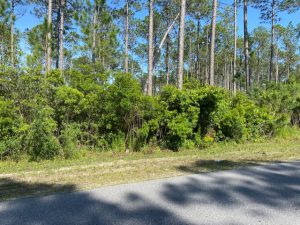
Photo courtesy: Stephen Greer Firewise Landscaping Heavy Understory Plant Growth
Plant selection considerations to the plant’s flammability potential should be a significant part of this process. First steps will include preparing the soil site according to Florida Friendly standards making sure the plants have a healthy establishment and future growth. This allows for greater moisture retention within the plant. The need to identify and use plants with low flammability characteristics is important in many ways including going with plants that grow more slowly with reduced natural dead branch production. Look for plants with open branching and with less leaf density.
There are three defense zones to mitigate potential fires near the home or other structures. Plan according to these three zones.
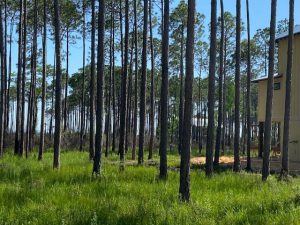
Photo courtesy: Stephen Greer Defense Zones
The immediate zone is within the 5-foot area of the structure. This is the area most vulnerable to embers being dispersed by the wind. Regular general maintenance on and around these areas is important to reducing places embers can settle and begin a fire. Make sure the roof and gutters are inspected and cleaned on a schedule and after storm events. Keep flammable materials such as firewood or leaf piles out of this area. Install permeable and impermeable hard surfaces and other noncombustible landscape in this immediate zone. The materials in this area can be stone, walkways and others.
The intermediate zone is the 5 to 30-foot area from the structure. Plan this landscape area with plants properly spaced to reduce fire jumping from plant to plant assisting in slowing the fire movement. Maintain lawn and native grasses to reduce excessive growth that can dry during certain times of year. Prune or remove overgrown plants under or near trees reducing the chance of the fire moving up into the canopy of the trees. Driveways and paths can service as fire breaks along with patios made of non-flammable materials.
The extended zone is the 30 to 100 plus foot zone from the structure. Spacing trees and other vegetation to keep fires small and manageable is the key. Keeping flames low to the ground and separated provides the chance to make mini-fire breaks. Be sure to remove any fallen or low dead branches from this area.
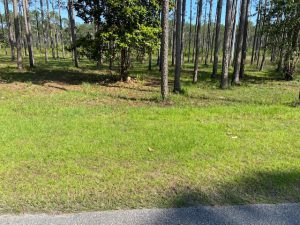
Photo courtesy: Stephen Greer Firewise Mowing
Become involved in neighbor or community conversations about best practices to prepare for a potential future wildfire event. It often takes hard work and focus to accomplish nearly a lifetime of building a home and setting it up to how you like it. Build time to plan for defending it from potential wildfires.

by Ashley Stonecipher | May 26, 2022
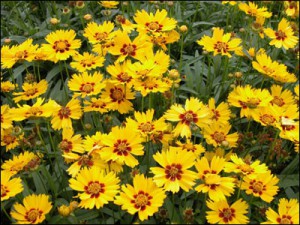
Coreopsis flowers. Photo courtesy UF/IFAS.
A beautiful wildflower that lines the roads and open areas is one of my favorite native pollinating plants. Coreopsis also commonly known as Tickseed was designated our Florida State Wildflower in 1991. It can be found throughout Florida and all 17 species occur in North Florida. Varieties such as Leavenworth’s Swamp (C.nudata), Florida (C. floridana) and Coastalplain (C. gladiata) are found in moist areas and other varieties like Lanceleaf Tickseed (C. lanceolata) and Goldenmane Tickseed (C. basalis) are commonly found in the drier areas of the landscape.
All the varieties of Tickseeds have daisy-like flowers with yellow petals except for the Swamp Tickseed which is more pinkish purple in color. The flower gets its common name by the appearance of the small ovalish seed that has two short spines at one end and looks like a ‘tick’. The most common coreopsis is Coreopsis leavenworthii. This plant can be found in moist pinelands and disturbed sites. You can spot the blooms of bright yellow ray petals with brownish central disk flowers from late spring through late fall. This coreopsis can reach 3 feet in height. It grows like a weed and can quickly establish itself on bare soil. Coreopsis is essentially an annual with our colder winters but produces many seeds that will multiply as long as the plant receives adequate sun and moisture. A special species of coreopsis found only here in the Panhandle is the Chipola coreopsis (C. integrifolia). It is less common and only found along the Chipola River. This 18-24” plant has deep green oval-shaped leaves and deep yellow flowers seen blooming in the Fall, maybe a great time to go kayaking or hiking along the river! The Chipola coreopsis prefers moist soils and some protection from the sun. This variety is so rare that it has been listed endangered by the Florida Department of Agriculture.
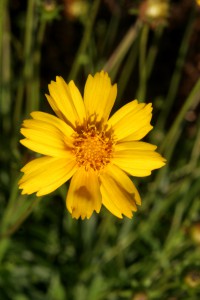
Native Lanceleaf Coreopsis. UF/IFAS Photo: Thomas Wright.
Coreopsis is pollinated mostly by small bees and not visited as much by butterflies and other pollinators. They are a great plant to use for a show of color! You can get seeds from your local garden center or from the Florida Wildflower Growers Cooperative (https://floridawildflowers.com). This Florida-Friendly plant is drought tolerant and can be sown anytime from October to January.
Sources:
https://www.flawildflowers.org/wp-content/resources/pdfs/Publications/AboutCoreopsis.pdf
https://gardeningsolutions.ifas.ufl.edu/plants/ornamentals/coreopsis.html
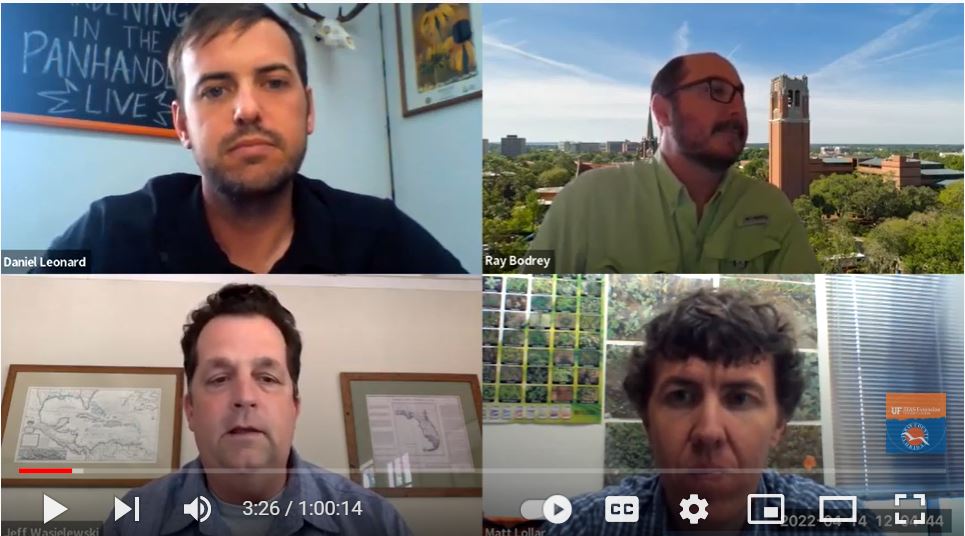
by Beth Bolles | May 26, 2022
The Q&A on Subtropical Fruits offered valuable information on many types of subtropical and temperate fruits of interest to homeowners. Below are the reference materials related to specific questions that were asked along with notes from the panel discussions.
How to protect tropical and subtropical fruit trees from freezes?
Freeze protection of TF crops outside of Miami-Dade County: https://www.youtube.com/watch?v=e1U7CrqX074
Cold protection in South Florida is mainly through irrigation practices. It takes irrigation to run before freeze and continue until freeze is over.
What are the easiest subtropical fruits to grow?
Loquat: https://edis.ifas.ufl.edu/publication/MG050
Home Citrus Culture Publications – UF: https://edis.ifas.ufl.edu/entity/topic/citrus_home_citrus_culture
What are the best citrus trees to grow on NE Florida?
Tangerine, Mandarin (Owari and Brown select mandarins), & Tangelo Varieties: https://edis.ifas.ufl.edu/entity/topic/tangerines_mandarins_tangelos
Can we grow papayas here?
Growing Papaya in the Home Landscape: https://edis.ifas.ufl.edu/publication/MG054
Papayas are grown from a seed, not from air layering or grafts. There are some disease issues from Papaya ringspot virus. May have to start new plants. Less than a year from seed to fruit. Seed can be all male, all female, or have both male and female flowers. Need to get rid of the males. Male flowers hang off the tree where females stick to the stem more.
What are the best varieties of limes to grow in the Panhandle?
Growing “Tahiti” Limes in the Home Landscape: https://edis.ifas.ufl.edu/publication/CH093
Tahita and Persian limes are in retail nurseries. These are cold sensitive so plant in protected areas. Key limes would need to be in a container for most people.
Rangpur lime is a lemon and mandarin cross.
Bananas continually produce nice foliage but do not form fruit in 5 years. What to do?
Maybe not spend any more time trying to get fruit. If the bananas are in a large clump, you don’t want to have a large clump. Cut them back so that you have 3 bananas, one large, one medium, and one small so that you get lots of light. That is the key to fruit. Remove brown leaves.
Can we grow a Barbados cherry successfully?
Malpighia glabra, Barbados Cherry: https://edis.ifas.ufl.edu/pdf/FP/FP39000.pdf
Small tree to about 6 feet x 6 feet. Mild flavor. Not really suitable for North Florida. Needs sunlight for fruit.
Can we get the transgenic papaya that is immune to the Ringspot virus?
TREC Fruit Specialist has the papaya but it is not legal to introduce them into Florida at this time.
Advice on growing kiwi vine.
Growing Kiwis in FL: https://nwdistrict.ifas.ufl.edu/hort/2019/04/09/kiwis-a-golden-opportunity/
Temperate fruit that requires chill hours. Golden varieties developed by Auburn University. AU Golden Dragon and AU Golden Sunshine. Need a substantial trellis. Male and female vines so male vine for every 2-3 females.
Crestview gets fairly cold in late winter. What fruit trees do well here?
Dooryard Fruit Varieties: https://edis.ifas.ufl.edu/pdf%5CMG%5CMG24800.pdf
Will Papaya fruits reach maturity in NW Florida?
Growing Papaya in the Home Landscape: https://edis.ifas.ufl.edu/publication/MG054
Papayas do not like the cold. Probably not likely to produce a fruit but can give it a try.
What about pineapples?
Good option in a container. Bromeliad that is terrestrial that is watered through the roots.
I planted an arbequina olive tree and it’s struggling. Keeping in pot and protected from freezing but not thriving.
Olives for Your FL Landscape: https://edis.ifas.ufl.edu/publication/EP515
Olives like a more consistent temperature than the Panhandle offers. Needs excellent drainage.
Mexican avocado has survived freeze and flooding but still not thriving. Why?
Avocado IPM: https://trec.ifas.ufl.edu/tropical-entomology/index.php
Hass avocado, smaller ones from CA and Mexico. South Florida is too warm to grow Hass but it may work in North Florida. Green skinned avocado is grown in South Florida. More tasty. Florida avocados need a little cool weather to initiate flower and then fruit.
Avocados will not like wet soils.
Will lychee and avocado grow in Pensacola?
Red fruit, white inside, similar to a grape but sweeter. Needs chill hours. 2018 lychee mite came into Florida and now in 13 counties. Difficult to manage.
Shade-tolerant subtropical fruits?
Fruit needs sun. Monstera deliciosa, Swiss cheese plant, produces an edible fruit grows in shade. Definitely needs protection. DO NOT eat fruit early or you will have mouth pain. Fruit should be falling apart.
Pawpaw is not tropical but grows in shade.
How to trim fruit trees?
Hand pruning and training of tropical and sub tropical fruit trees: https://edis.ifas.ufl.edu/publication/HS1372
Often prune for size control in South Florida to encourage lateral growth and get sunlight into the center.
Which banana trees thrive here?
Banana Growing in the Florida Home Landscape
https://edis.ifas.ufl.edu/publication/MG040
What subtropical fruits are garnering the most interest in the panhandle right now?
Loquat Growing in the Florida Home Landscape: https://edis.ifas.ufl.edu/publication/MG050
Mangos are of most interest in South Florida
What about akee?
Caribbean fruit related to lychee. Do not eat before ripe or you will die.
The good pH for blueberries and raspberries
Blueberry Gardener’s Guide: https://edis.ifas.ufl.edu/publication/MG359
What plum varieties are recommended?
Fruit Tree Recommendations for AL: https://ssl.acesag.auburn.edu/pubs/docs/A/ANR-0053-F/ANR-0053-F-archive.pdf
Finger limes are the new hot crop at the TREC.














